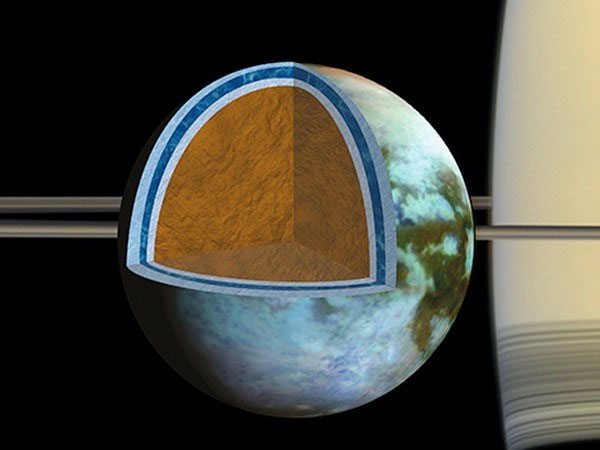The new discovery shook the hypothesis of life on Titan
The ocean on Titan, Saturn's largest moon, may have salt concentrations equivalent to the Dead Sea on Earth.
This is the research result of the US National Aeronautics Agency (NASA) announced on July 2.
NASA's latest research, published in Icarus magazine, is based on gravity and terrain data collected by space exploration ship Cassini during flights to Titan over the past 10 years.
Analyzing Cassini's data, NASA scientists reconstructed the structure of Titan's complete model, including the underlying ice as well as the ocean beneath it.

According to this model, scientists identified Titan's ocean as having a relatively high density to produce the gravitational parameters as collected.
Thus, the possibility is given that this ocean's water contains a huge amount of salt with the main component being sulfur, sodium (Sodium) and potassium (Potassium).
NASA estimates salt concentrations in seawater on Titan could be equivalent to the Dead Sea salt concentration on Earth.
Lead researcher Giuseppe Mitri of the University of Nantes, France, points out that the results of this hypothetical ocean change may be a place to nurture life in the present time.
In addition, Cassini's parameters also show that the surface of Titan's ice is relatively uniform. The cause of this is because the moon's outer shell is very hard when the ocean is crystallized and slowly freezes.
On the other hand, the surface of this moon tends to self-level over time like warm candle wax. This freezing process has an important effect on Titan's ability to survive in the ocean, because it limits the ability of matter to exchange between surface and ocean.
The discovery of the ocean on Saturn's moon Titan is seen as a major step forward in the quest for a life-like planet like Earth. However, the new findings may quell hope for life that exists on Saturn's largest natural satellite.
- Earth creatures migrate to Titan planet?
- Titan moon can nourish life
- A new theory about the Earth - when life begins
- Hope to find extraterrestrial life on Saturn's Titan moon
- Detecting signs of life on Saturn satellite
- Detecting cell membrane material on Titan moon
- See the 'foggy sunset' on Saturn's moon
- The hidden surface of Titan satellite's life
- New computer model about Moon Titan
- NASA finds 'an alien Earth'
- Find the river on Saturn's moon
- The 1.6 billion year fossil shook the theory of life on Earth
 Van Allen's belt and evidence that the Apollo 11 mission to the Moon was myth
Van Allen's belt and evidence that the Apollo 11 mission to the Moon was myth The levels of civilization in the universe (Kardashev scale)
The levels of civilization in the universe (Kardashev scale) Today Mars, the sun and the Earth are aligned
Today Mars, the sun and the Earth are aligned The Amazon owner announced a secret plan to build a space base for thousands of people
The Amazon owner announced a secret plan to build a space base for thousands of people Why is finding a missing submarine in the ocean like 'looking for a needle in a haystack'?
Why is finding a missing submarine in the ocean like 'looking for a needle in a haystack'?  Piercing submarines and daring to fight humans: How did this creature, once as small as a grain of rice, do it?
Piercing submarines and daring to fight humans: How did this creature, once as small as a grain of rice, do it?  Where the world's oceans meet
Where the world's oceans meet  Hurricane Dora makes history with its bizarre path across the ocean, from the Americas to near Asia
Hurricane Dora makes history with its bizarre path across the ocean, from the Americas to near Asia  NASA robot captures 'living ocean' on Mars
NASA robot captures 'living ocean' on Mars  Do aquatic animals pee?
Do aquatic animals pee? 